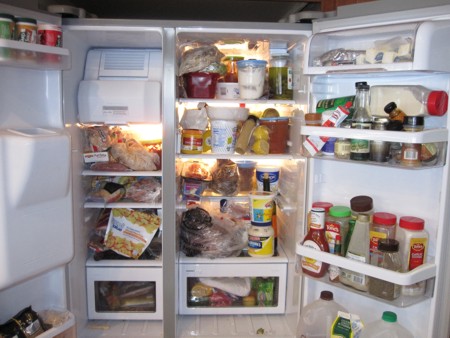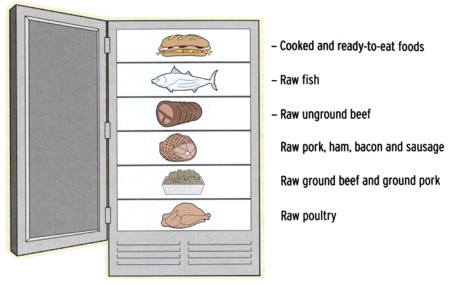Believe it or not, there is a ‘proper’ way to arrange foods in your fridge and freezer. And following these simple guidelines will help you keep foods fresh longer and help minimize cross-contamination.
 A typical messy, overstuffed fridge. Nobody wants to know
A typical messy, overstuffed fridge. Nobody wants to know
what’s at the back on the bottom shelf!
Temperature control
Your fridge should always be set between 34F (2C) and 40F (4C). Preferably closer to 34F (2C). Your freezer should always be set as low as possible. That is, if you have a separate freezer compartment in your fridge, which has a separate temperature control, set it to 0F (-18C). That’s the optimum deep freeze setting used by professional foodservice operators. ‘Just frozen’ isn’t good enough to get you all the benefits that freezing has to offer.
For one thing, if the power goes out, you’re only a few degrees away from a disastrous thaw if you only freeze to just below 32F (0F). If you have kept your freezer at 0F (-18C), you have several hours of leeway before your frozen food comes anywhere near the Danger Zone. Just don’t open the freezer door!
Humidity control
Most fridges made within the past 30 years or so have a ‘crisper’ tray, ostensibly for optimum storage of veggies. In the past 20 ears, most fridges have also come with a ‘butter keeper’, in the door. New fridges have all manner of special compartments and drawers, designed to control temperature and humidity to optimize storage of meats, cheeses, fruits, root vegetables, leafy vegetables and just about anything you can imagine.
Forget all that for a moment…
Rule # 1: It’s always colder at the bottom of the fridge than at the top. That’s why the ‘butter keeper’ is always at the top of the door. So the butter will stay spreadable!
Rule # 2: Water runs downhill. So don’t store liquids or potentially drippy raw foods on top!
Rule # 3: FIFO! ‘First In, First Out’. Make sure that you use the oldest foods in your fridge first and keep them rotated to the front of the compartment. This is especially important when dealing with leftovers, which can sit at the back of the shelf forever, waiting for their ‘encore’. It’s also important in reference to fresh herbs, leafy vegetables, soft fruits and other delicate, perishable foods.
Rule # 4: Follow the top-to-bottom stacking sequence for all foods:
Rule # 5: Don’t over-stuff your fridge. You can’t see what’s behind the front row of containers on any shelf, or in the bottom of the deep compartments. This just leads to stuff being forgotten and going disgustingly bad, making another really disgusting job for you at fridge wipe-down time.
Rule #6: Clean out your fridge weekly, or at the very least, every two weeks. I mean take everything out of it, examine the Best Before dates, check the freshness of all items, dump any leftove4rs that are more than three days old. A lean fridge is a clean fridge is a happy fridge! Clean all the walls, shelves and compartments with warm, soapy water and dry with a clean, fresh towel.
Rule # 7: Don’t buy more than you can use! Shop two or three times a week, for only those fresh foods that you want to use today and tomorrow. You should always have staples on hand, restocking when you see them getting low. These include, such as dry herbs and spices; flour, sugar, baking soda and powder; butter, margarine and cooking oils; onions, carrots and celery;milk and eggs.
We’ll talk about how to judge the freshness of foods at the market in the next installment of our Kitchen Safety Series!
~ Maggie J.


Thanks again for the blog post. Want more!
I found your blog site on Google and read a number of your early posts. Continue to keep up the excellent work!
Aw, this was a very nice post. I thought I would like to put in writing like this additionally – taking time and actual effort to make an excellent article… however what can I say… I procrastinate a lot and in no way appear to get one thing done.
Very neat article post. Fantastic.
I’m thankful for the blog article. Really, thank you! Awesome.
– Daniel Beaulieu